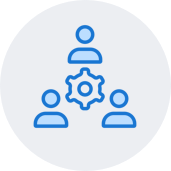Strengthening the skills, abilities and competencies of your workforce through a talent development plan, ensures that your employees are agile and able to meet organizational goals.
In effective organizations, all employees, regardless of background, are developed to ensure sustained success. Talent development should reflect the opportunity for formal and informal growth to strengthen an employee’s hard skills and soft skills.
Free, High-Quality Resources
Reintegrating the Formerly Incarcerated into the Workforce
Article by Emily Engel: Methods of five organizations in the Midwest to address persistent unemployment for the formerly incarcerated.
Mentoring Formerly Incarcerated Adults
Report from Annie E. Casey Foundation: Insights from the Ready4Work Reentry Initiative.
Leading with Conviction
Report from the Center for Institutional and Social Change at Columbia Law School: The Transformative Role of Formerly Incarcerated Leaders in Reducing Mass Incarceration.
Training for Emerging Leaders
JustLeadership USA offers training and development opportunities specifically for people with connections to the criminal legal sysm
Creating a Mentoring Program
SHRM: Creating a mentoring program within your organization.
Corporate Learning Programs
SHRM: How companies – big and small – are making highly tailored, responsive training a reality.
Developing Employees
SHRM: Toolkit with strategic and practical considerations for employers creating or maintaining employee development programs.
Types of Employee Development
Whether the development occurs on the job with an experienced co-worker, at a training facility, or online, employee development is critical to every organization.

Coaching
Coaching involves a more experienced or skilled individual providing an employee with advice and guidance intended to help him or her gain new skills, improve performance and enhance the quality of his or her career.

Mentoring
Mentoring matches less experienced employees with more experienced colleagues through formal or informal programs.

Development Plans
An individual development plan (IDP), details an employee’s intentions and learning outcomes as well as provides the support necessary to meet his or her tangible growth goals. Beneficial IDPs reflect adult learning strategies, experiential learning and symbolic interaction.

Stretch Assignments
On-the-job training projects and “stretch assignments” give employees a chance to learn while doing real work. Developmental assignments allow employees to develop new skills, knowledge and competencies necessary for higher-level positions.

Cross-Training
Cross-training refers to training employees to perform job duties other than those normally assigned. Cross-training can be a short-term or ad hoc fix, or it can be an ongoing, planned process.

9-Box Grid
The 9-box grid is an individual employee assessment tool that evaluates the employee’s current and potential levels of contribution to the organization and can include appraisal and assessment data.

Job Enlargement & Enrichment
Job enlargement involves expanding the employee’s job by adding more tasks and duties, typically at the same level of complexity. Job enrichment builds more depth to an employee’s job through more control, responsibility and discretion.

Job Shadowing
Job shadowing gives the employee a view of the organization from a different perspective and allows him or her to learn firsthand about the challenges facing colleagues in other departments.

Job Rotation
Job rotation is the systematic movement of employees from job to job within an organization. Rotation programs may vary in size and formality.

Assessment Centers
An assessment center is a program of tools and exercises designed to assess an employee’s or job candidate’s suitability in relation to a particular role.

Corporate Universities
Corporate universities focus primarily on on-the-job skills, company-specific proprietary knowledge and branding that will benefit the organization and the individual.

E-Learning
Online training allows self-directed, just-in-time, on-demand instruction. Employees in e-learning situations have more control over their time than they have in a classroom.
